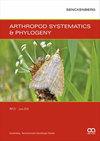An integrative revision of the subgenus Liophloeodes (Coleoptera: Curculionidae: Entiminae: Polydrusini): taxonomic, systematic, biogeographic and evolutionary insights
IF 1.8
2区 农林科学
Q2 ENTOMOLOGY
引用次数: 4
Abstract
The subgenus Liophloeus Weise, 1894 of Liophloeus Germar, 1817 (Coleoptera: Curculionidae: Entiminae: Polydrusini) consists of five morphologically similar species traditionally diagnosed based on the shape of the aedeagus. However, traits of the genital apparatus exhibit substantial and overlapping interand intraspecific variation. All five species have the same ecological requirements and occur in central and eastern Europe, mostly in montane areas. The focus of this work was to verify the taxonomic status and validity of Liophloeodes species using a combination of molecular and morphometric techniques. Specimens were collected from the entire distribution range and initially assigned to a species according to the aedeagal shape. Genetic diversity and phylogeny of the subgenus were studied using three molecular markers (two ribosomal, 28S-D2 and ITS2, and one mitochondrial, COI). Moreover, several morphological characters were used for multivariate morphometric analyses. Finally, presence and prevalence of bacterial endosymbionts among species were investigated. Phylogenies based on ribosomal markers suggest that traditional species are correctly delimited, whereas COI phylogeny suggests hybridization and introgression occurring between Liophloeodes species. Morphometric analyses confirmed low interspecific diversity. Two major bacterial endosymbionts, Rickettsia and Wolbachia, were detected in many populations. We argue that Liophloeodes consists of young lineages whose evolution and diversification was possibly mediated by cyclic climate change events.石竹蝗亚属的综合修订(鞘翅目:石竹蝗科:石竹蝗科:石竹蝗科):分类、系统、生物地理和进化见解
1817年,德国,1894年,德国,Liophloeus Weise亚属(鞘翅目:Curculionidae: Entiminae: Polydrusini)由五个形态相似的物种组成,传统上是根据aedeagus的形状进行诊断的。然而,生殖器官的性状在种间和种内表现出大量重叠的变异。这五种植物都有相同的生态需求,分布在中欧和东欧,主要分布在山区。本工作的重点是利用分子和形态计量学相结合的方法来验证该物种的分类地位和有效性。从整个分布范围收集标本,并根据翅形初步划分为一种。利用2个核糖体28S-D2和ITS2和1个线粒体COI分子标记研究了该亚属的遗传多样性和系统发育。此外,一些形态学特征被用于多变量形态计量学分析。最后,研究了细菌内共生体在物种间的存在和流行情况。基于核糖体标记的系统发育表明,传统的物种是正确划分的,而COI系统发育表明,化石物种之间发生了杂交和渗入。形态计量学分析证实了低种间多样性。在许多人群中检测到两种主要的内共生细菌立克次体和沃尔巴克氏体。我们认为石虫科由年轻的谱系组成,其进化和多样化可能是由周期性气候变化事件介导的。
本文章由计算机程序翻译,如有差异,请以英文原文为准。
求助全文
约1分钟内获得全文
求助全文
来源期刊

Arthropod Systematics & Phylogeny
Agricultural and Biological Sciences-Insect Science
CiteScore
2.50
自引率
5.60%
发文量
26
审稿时长
12 weeks
期刊介绍:
Arthropod Systematics & Phylogeny releases three times per year. Research fields covered are the taxonomy, morphology/anatomy, phylogeny (molecular or morphology-based), historical biogeography and palaeontology of arthropod taxa.
Arthropod Systematics & Phylogeny is the successor of Entomologische Abhandlungen, formerly published by the Museum of Zoology Dresden, Germany.
 求助内容:
求助内容: 应助结果提醒方式:
应助结果提醒方式:


